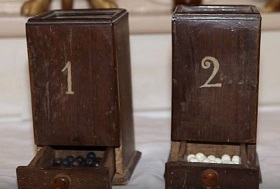The Archconfraternity of the Blessed Sacrament is the most long-lived of the six Confraternities present in Putignano and among all the ancient institutions of the town only the Mother Church of San Pietro Apostolo, the Church of Santa Maria la Greca and the University (today's Municipality) they can boast a previous foundation date.
The original name of the congregations at the time of their constitution was "Brotherhoods of the Body of Christ", which still remains today in the dialectal denomination of these brothers who are usually called the "Brothers of Crest"; later transformed into Confraternities of the Blessed Sacrament thanks to the Council of Trent (1543-1559) wanted by Pope Paul III Farnese (1534-1549). The latter proposed this modification to respond to the lacerations made by the Lutheran Reformation by initiating in this sense a profound internal and external renewal of the Church which will then culminate in the Council of Trent which he himself convened and which will later be known as the Counter-Reformation.
The establishment of the Confraternity was made in the Church of Santa Maria sopra Minerva in Rome in 1539 to arouse greater respect and veneration of the Blessed Sacrament both in the church and on the occasions when it was removed from churches such as Viaticum for the sick or in procession . establishing that all the Confraternities constituted everywhere under the same invocation of the "Sacred Body of Christ" enjoyed the same privileges, concessions, indulgences, faculties, graces of the Roman Confraternity.
The foundation of the Confraternity in Putignano took place with a Public Parchment Document of 23 April 1574 issued by the Vice Chancellor of the Roman Church Cardinal Alessandro Farnese Bishop of Frascati, nephew of Paul III.
Initially it was based in the church of San Pietro and the group included all the capitular priests and also the laity with the aim of promoting the cult of the Eucharistic Mystery, keeping the decoration of the altar where it is kept, to accompany it when it is brought to the sick and in all processions and solemn celebrations and always provided what was necessary in the functions of Corpus Domini, the Forty Hours, in the Holy Sepulcher and in Viaticum, administering wax, oil for lamps and whatever else was necessary. In addition to his own chapel in San Pietro, he also obtained the small church of Santa Maria di Costantinopoli following the conclusion of the Chapter of San Pietro on 6 April 1612 and following the testament of judge Pietro Romanello drawn up on 27-11-1558 by the notary Giovanni Carusio with the burden, as was customary in those days, of having you celebrate one Mass a week for his soul and another two a month for his parents.
In 1768 it was reserved for lay people only and adopted new rules which received Royal Assent on 28-2-1769.

In 1840 he applied to the Government to be elevated to the status of Archconfraternity and obtained a favorable Royal Decree of 18-12-1840 with the obligation to compete with an annual duchy of 30 at the Cassa dei mendici. With the daytime rank of the brotherhood vote, the Archconfraternity is always the last to parade in all the processions in which the other brotherhoods participate.
To date, the number of confreres cannot exceed the maximum number of 51; some of the older ones no longer attend because they are unable to attend for health reasons and therefore their subrogation would be possible. Each of the members of the archconfraternity has a say in the decision to be taken on any subject. As evidence of this, there is the pair of urns, the very ancient cec'r bianch and cec'r gnur (white chickpeas and black chickpeas) used to vote for or against the proposals under discussion.



 This website project born from the idea of Gianni Musaio is enclosed in a team spirit and is the result of the collaboration of people, ordinary citizens, who care about the historical, cultural, artistic, geographical, food and wine heritage of the historic center of Putignano, a town in to live.
This website project born from the idea of Gianni Musaio is enclosed in a team spirit and is the result of the collaboration of people, ordinary citizens, who care about the historical, cultural, artistic, geographical, food and wine heritage of the historic center of Putignano, a town in to live.